Karpas Protected Area
The Karpaz SEPA (Special Environmental Protection Area) first received legal protection when it was made a National Park under the TCc Forest Law, and the protection has subsequently been extended when it was made a Special Envrionmental Protection Area under the 1997 TCc Environment Law. Several regions within the area are also protected by virtue of their archeological importance due to the many important historic sites they contain.
The protected area is situated at the eastern extremity of the Karpaz peninsula, and has coastline on both the north and south borders extending to a total length of 103.5km. The land area of the protected area covers a total area of 9,645 ha. and the habitats consists of an extensive interior region with hill formations, open plains with stream beds and the coastal zone. The protected area extends into the marine zone for one kilometre to provide protection for important areas containing posidonia beds (an important sea grass), and to provide a buffer zone to reduce disturbance for the marine animals using the area.
The protected area begins on the north coast at Ronnas Beach, extending east towards Dipkarpaz village. Ronnas beach is one of the most important nesting sites in the mediteranean for the Green turtle (Chelonia mydas), and annually contains approximately 200 nest sites. This makes the Ronnas beach the third most important site in the mediteranean basin for this endangered species. The protected area continues east along the north coast to Ayphilon Beach and also includes the interior terrain after the Ayphilon beach extending all the way to the eastern-most tip of the island.
The site has been selected as a potential NATURA 2000 site due to the presence of a combination of important habitats which are listed in Annex I of the Habitats Directive (Council Directive 92/43/EEC of 21 May 1992 on the conservation of natural habitats and of wild fauna and flora) and the presense of a number of species which have national and/or international importance in nature conservation terms.
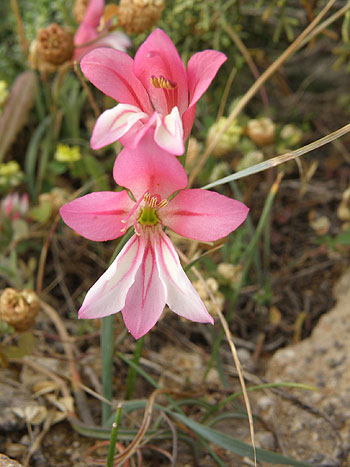 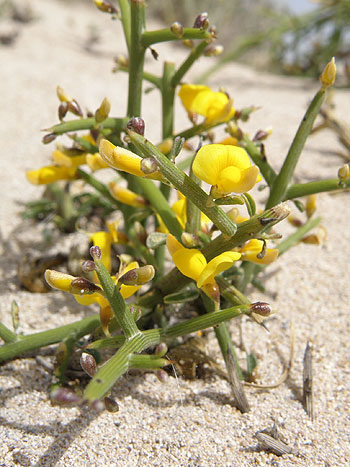
---- Gladiolus tryphyllos (endemic to Cyprus) - - - - - - - - -Calycotome villosa (common) ----
The vegetation structure of the site is of a typical coastal Mediterranean nature, with stretches of both sandy and rocky shoreline. There are large areas which retain their natural features, such as mattoral and sand dune systems, which are very unique and important in both a local and international context. Survey work within the protected area has identified that it contains13 different EU priority habitat types, listed as important for conservation under the Habitats Directive (Dir 92/43/EEC).
Survey work and research has identified that the Karpaz protected area provides a habitat for many endemic and rare plant species. The Red Data Book of the Flora of Cyprus (Tsintides et. al 2007) listed four different plant species which are rare plant species for the island. According to the Red Data Book, red listed plant species occurring in Karpaz SEPA are: Euphorbia paralias (Endangered), Juncus maritimus (Vulnerable), Salsola soda (Vulnerable), Valantia muralis (Endangered) and Ophrys kotschyi (Vulnerable). There are also many endemic plant species of which some are IUCN red listed, Annex II species or listed under Bern Convention.
A significant part of the protected area is designated as forestry land and is controlled by the Forestry Department. Much of the Forest areas, which are principally covered in Pinus species close to Ronnas Beaches and elsewhere is dominated by shrubs (mainly Juniperus), which is the region’s original vegetation type, have been protected by the management regime and has not been damaged through agricultural activities.
At various sites within the region management by the Forestry Department has included reforestation in the region with plantations consisting of Pinus, Acacia and Eucalyptus.
The Karpaz protected area contains important areas for marine turtle nesting, monk seals, nesting birds and bird migration. Two species of marine turtle, the Green turtle (Chelonia mydas) and the Loggerhead turtle (Caretta caretta) nest on the beaches found within the protected area. Globally the Loggerhead turtle is categorised as endangered on the 2000 IUCN Red List (Hilton-Taylor 2000), and until recently the population of Green turtle in the Mediterranean was considered a sub-population and was therefore classified by the IUCN as critically endangered.
Also resident at a number of locations within this site is the Egyptian Fruit Bat (Rousettus aegiptiacus), which is of international importance as Cyprus is the only European country to provide a home to this species, and the extremely rare Mediterranean Monk Seal (Monachus monachus) frequents the coast line, utilising coastal caves which provide important resting and pupping sites for the animal (Haigh 2004, Gücü 2007).
Other species present within the protected area which attract a high degree of protection, and are concervation importance include the Greater Horseshoe Bat (Rhinolophus ferrumequinum) (Benda et al 2007) which both breeds, feeds and roosts within the protected area. The Karpaz protected area lies on the flight path of hundreds of thousands of migratory birds during spring and summer migrations and sees a seasonal influx of migrant birds which seek shelter and rest within the area.
The endemic Cyprus Wheatear (Oenanthe cypriaca) and Cyprus Warbler (Sylvia melanothorax) are present and both species breed within the zone. The Cyprus Warbler, which prefers areas of low open maquis which includes Calycotome villosa and Genista sphacelata species, in which to feed, rest and nest is particularly numerous on migration.
Other species seen during either spring or autumn migrations are Common Cranes (Grus grus) Honey Buzzards (Pernis apivorus) and Marsh Harrier (Circus aeruginosus). Probably the single most important location for bird species is the Kleidhes Islands; these islands are located directly off of the eastern tip of the Karpaz peninsula and provide a nesting site for two species flisted as of conservation concern by the EU Birds Directive, the Shag (Phalacrocorax aristotelis desmarestii) and the Audouins Gull (Larus audounii). The Audouins Gull is found only in the Mediterranean region and the western coast of Saharan Africa. It breeds on small islands either colonially or alone, laying 2-3 eggs on a ground nest. During the late 1960’s its global population fell to approximately 1000 pairs, making it one of the rarest gull species in the world. Since this time it has established new breeding colonies, but still remains relatively rare with an estimated population of around 10, 000 pairs.
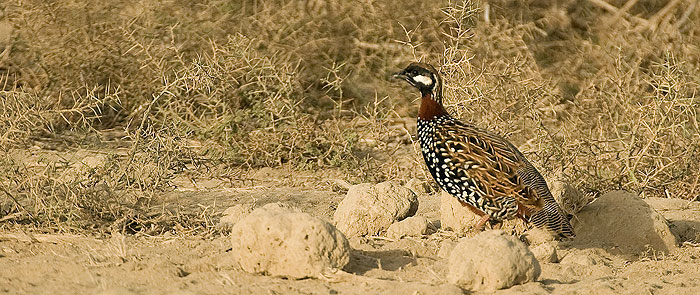
Black Francolin - Francolinus francolinus - a common bird in the Karpas protected area.
For invertebrates, there are two endemic species of butterfly found within the boundaries of the protected area, the Cyprus Meadow Brown (Maniola cypricola) and the Paphos Blue (Glaucopsyche paphos). In addition to these endemics, there are also three nationally rare species Two-tailed Pasha (Charaxes jasius), Pigmy Skipper (Gegenes pumilio), Lang’s Short-tailed Blue (Leptotes pirithous) (Ozden 2006) found within the boundaries of the Karpaz SEPA.
The weather throughout the year remains mild with temperatures above 0 °C and the lowest recorded temperature during the winter months, normally occurs in February. The average temperature is 20 °C in the region and the highest recorded temperatures are in the months of July and August, with a daily average of 29°C. During the winter months, the average dailty temperature is 12 °C. The annual rainfall is approximately 700mm, however, the climatic conditions vary considerably between years and during some months and years there will be hardly any rain.
The economy of the region revolves mainly around low intensity agriculture and animal husbandry carried out by local resident farmers. Manyl residents earn an income from the olive and carob trees planted in their fields on an annual basis, and wheat, barley and oat is planted in many fields. In addition to the agriculture there are a small number of bed and breakfast style accommodation and restaurants servicing the tourism industry both within the village and scattered within the protected area.
Some of the establishments in the village provide services for alternative tourism activities such as nature walks, agro-tourism, and scuba diving. In addition to coming to enjoy the natural beauty of the area, a high number of visitors comes to the region to visit the St. Andreas Monastery. The stalls surrounding the Monastery are generally operated by the village women who sell souvenirs, handicrafts as well as Lefkara lace.
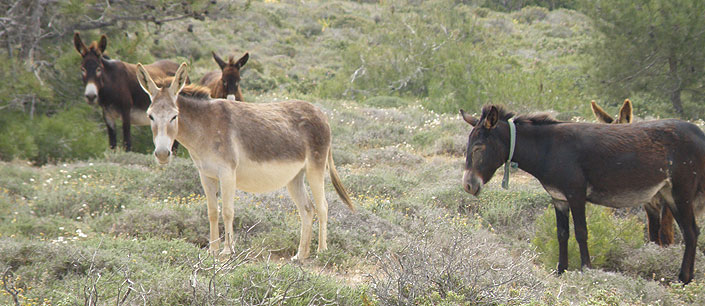
---- Feral donkeys living wild on the Karpas ----
Within the Karpaz SEPA many ancient settlements have been identified from various historical periods. Some of these ancient sites include the Ancient Karpasia City, Ancient Karpasia Harbour, Tsambres Necropolis, Anavrysia Necropolis, Latsia Necropolis, Ancient stone querries, Urania Ancient City, Agridia Ancient City, Khelones Ancient City and Kastros Settlement.
In terms of cultural heritage, Apostolos Andreas Church and the Monastry (middle age) remain important sites of worship for many people of the Christian faith. Other sites of interest include Ayios Philon Church and the Monastery (early – middle Byzantine), Ayios Yeorgios (middle Byzantine), Panaya Asomataos (early – middle Byzantine), Panaya Chrissiotissa (early-middle Byzantine) and Afrodit Akraia Temple (Helenistic and Roman Periods) (Öztek, 2005).
Habitat Maps
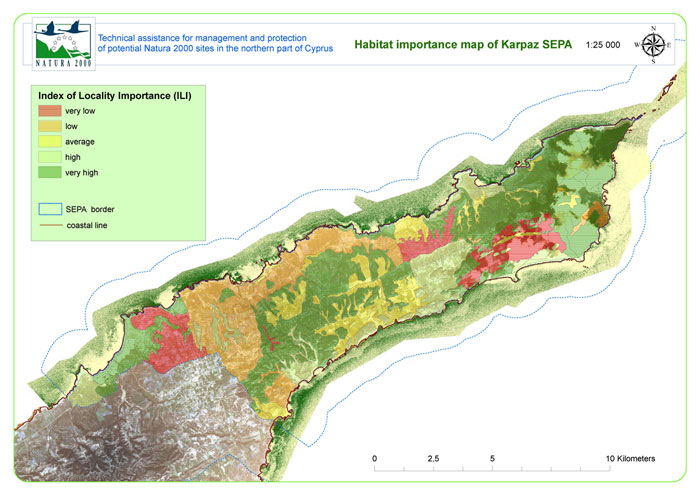
|